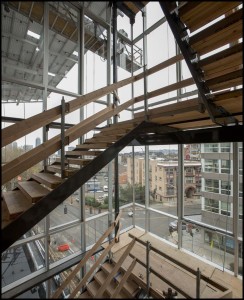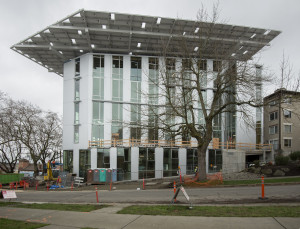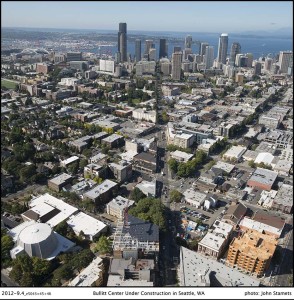KC Golden: Reflections on the Bullitt Center
“The Stone Age didn’t end because we ran out of stones. We transitioned to a better solution.”
Comment by departing Energy Secretary Steven Chu, February 2013

(C) John Stamets
KC Golden of Climate Solutions sees energy conservation and energy efficiency as crucial in a transition to a clean energy future. The Bullitt Center stands as a living example of how we can address the energy challenge to slow climate change.
Climate Solutions is an organization based in the Pacific Northwest that focuses on practical, economically feasible solutions to climate change. They develop and support projects that offer businesses and communities ways to transform to a clean energy model, creating stronger, healthier, more resilient economies. Climate Solutions works to pass leading-edge statewide environmental policies, bringing a positive, can-do approach to a daunting issue. The Climate Solutions team knows that a clean energy economy brings broadly shared economic prosperity.
In a conversation with KC Golden, head of the Policy Leadership Program at Climate Solutions, we discussed the Bullitt Center’s impact on our community and beyond. KC felt that the key to this project is its creation of a hands-on example of a new standard for buildings. This building will serve as a living demonstration project to advocate exceptional building performance as the new norm.
KC lamented our current state of denial. Objectively we are in the middle of an emergency, but we ignore it. The power of the Bullitt Center project is that it provides a concrete example of what our future can look like. It proves we can achieve transformational results with current technology. There is no substitute for the real thing, for walking into the building to see how it can work.

(C) John Stamets
The three decades of investment in energy efficiency in our Northwest states has delivered energy savings sufficient to power more than four cities the size of Seattle. This translates into savings of more than two billion dollars a year in energy bills. Conservation has allowed us to do more work with our current regional hydropower system, saving us the costs of building new, expensive plants. Efficiency and conservation are the means to boost the economy and slow the trajectory of climate change. The energy we have saved through efficiencies has met more than half of the growth in demand and has saved us the significant cost of buying that amount of power at current prices.
When we move from fossil fuels to clean energy we create new jobs and investors make money in the new technologies. In contrast, when we purchase fossil fuels our dollars are taken out of our economy and the economy suffers a loss. New fuel economy standards will save far more oil than the Keystone pipeline would deliver. KC estimates that there is $5 billion lost each year by the population of King County paying for fossil fuels. If we take that money back via more efficient cars and other innovations and spend it locally then we create new jobs with the money saved at the pump.
Wasting less energy is a centerpiece to the solution of global warming. In Europe the population lives comfortably while using half the energy we do here. KC estimates that with energy efficient codes, standards, commissioning, and incentives our region could save enough energy to meet all foreseeable growth in demand for the next 20 years.
A draft of the Third National Climate Assessment points to climate change as the cause of environmental changes and national disasters such as those we have recently seen at home and in the news: heavier rains, sea-level rise, and drought. Climate change is accelerating at a faster pace than previously predicted, and it results in hotter, colder, drier, and rainier weather patterns – bigger extremes, and more damaging catastrophes. 2012 was the hottest year on record in the U.S. according to the National Oceanic and Atmospheric Administration.
President Obama’s Inaugural Address gives hope that change is afoot in Washington. Politics has been standing in the way of good economics, according to KC. But hopefully that is changing. In a recent article in the New York Times, it was suggested that wind and solar projects should benefit from the same tax advantages used by gas and oil companies. By making it a level playing field renewable energy sources become more economically competitive.
The City of Seattle has long been a leader in sustainability. The City has set a goal of reaching carbon neutrality by 2050. The Green Ribbon Commission, in its December 2012 report, outlines steps to reach that goal: improving energy efficiency in existing buildings, building highly efficient new buildings, expanding infrastructure that supports renewable energy, and creating market incentives and financing options to encourage this work. By incentivizing conservation and increasing market value for energy efficient buildings, demand will grow, energy will be conserved, and new jobs will be created to implement the energy-efficient protocol.
The Bullitt Center is a beacon of hope. Buildings in the US consume 75% of the total electricity, produce 42% of the CO2 emissions, and produce 136 million tons of waste annually, so creating a project which points to a new way of doing things can have a big impact. How does a place become a signature of a culture? The Bullitt Center can be seen as Seattle’s Statue of Liberty, as the essence of Seattle. It can be a reflection of who we are and what we are aspiring to be.

